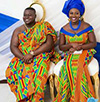 The traditional costumes of Ghana are not just beautiful. The culture of this country and its ancient heritage influence the folk clothing much. That’s why the designs, fabrics, and patterns aren’t random. They are used by Ghanaians for a long period of time, and therefore, they carry the old knowledge and tradition. At the same time, the national outfit of Ghana looks so bright and festive that it brightens the mood of everyone around.
The traditional costumes of Ghana are not just beautiful. The culture of this country and its ancient heritage influence the folk clothing much. That’s why the designs, fabrics, and patterns aren’t random. They are used by Ghanaians for a long period of time, and therefore, they carry the old knowledge and tradition. At the same time, the national outfit of Ghana looks so bright and festive that it brightens the mood of everyone around.
One of the main clothing crafts in Ghana is the weaving. Locals had wooden looms and produced handmade fabric long before the colonization of this land. They wove cloth from cotton and raffia fibers (widespread African palm tree). This craft isn’t forgotten even today. Ghanaians still use their traditional looms to make Gonja cloth and kente cloth – national clothing of Ghana is usually made from these fabrics.
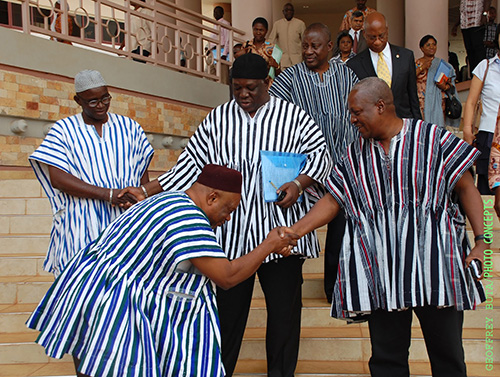
Men in Ghanaian smocks and various caps. Photo from Photoconcepts2.blogspot.com
Though the traditional dress of Ghana is very bright, merry, and pretty, Ghanaian costumes are experiencing serious problems today. Lots of cheap second-hand clothes are delivered to Ghana from Great Britain and other European countries. So, locals don’t have to spend time, efforts, and money to make outfits by the traditional techniques and methods. Every year, more people give up on wearing Ghana-produced clothing and replace it with modern European garments. By the way, such second-hand costumes received a smart and odd name “Obroni Wawu” (it is translated as “the dress of the dead white man”). To fight the habit of wearing cheap second-hand garments, local authorities and top managers of large companies even implemented a new tradition: they ask their employees to wear traditional African outfits on Fridays. This tradition is called “thank Ghana it’s Friday”.
Most popular garments in Ghana
Ghanaian smock
The traditional garments of Ghana are the kente cloth and the Ghanaian smock. The smock is made from the fabric called “Gonja cloth”. The kente cloth is originated from Southern Ghana, while the Gonja cloth – from Northern Ghana.
Gonja cloth – thick striped cotton fabric. The cotton is picked, dyed, and woven by hand. Usually, the pattern on this cloth is blue/black and white stripes. Long narrow pieces of fabric (about 4 inches wide) are woven and then sewn together or sold in rolls.
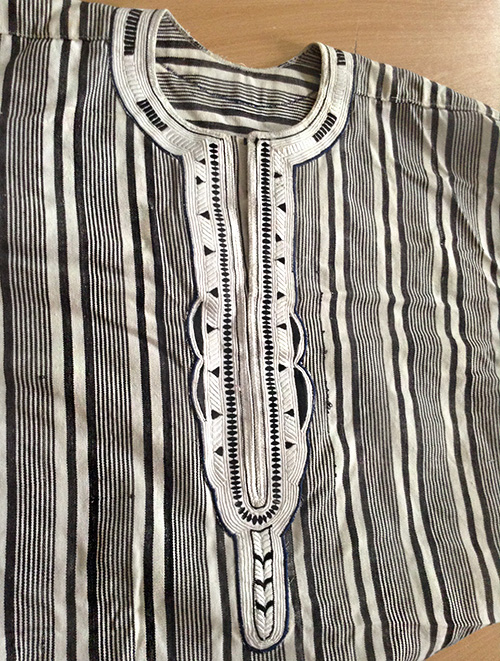
Embroidery pattern on the neckline of a male Ghanaian smock
Ghanaian smock (there are other names, for example, “dansika”, “fugu”, “batakari”, etc.) is a garment that resembles a shirt. It is mostly worn by men but there are female versions. Usually, the neckline and sometimes the front part of the smock is embellished with embroidery. The threads used for the embroidery pattern are white or blue&white. The pattern on the fabric itself is a combination of black and white or blue and white stripes of different width. The smock is worn with a kufi cap (a small round skull-cap widely used in Africa) or a red fez hat.
Kente cloth
Kente cloth is another traditional garment of Ghana. It is a handwoven piece of fabric with very colorful and symbolic patterns. This outfit is mostly worn for special occasions, ceremonies, and celebrations. The garment is very important for Ghanaian culture. First kente appeared about a 400 years ago. It was woven from raffia palm fibers and the tissue structure looked like a basket. At first, kente cloth was used only by royalty but later it became an item for ordinary people. Nowadays, kente cloth is made from cotton, and this clothing fits African climate perfectly.
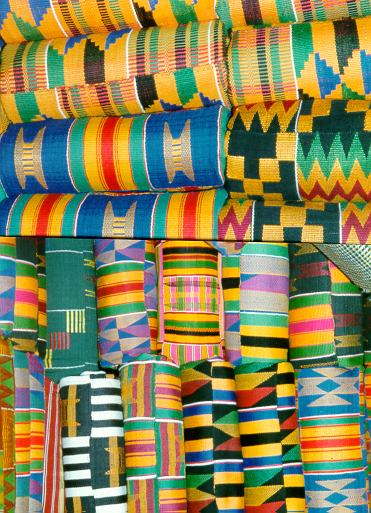
Rolls of kente cloth with different patterns. Photo from Wikipedia.org
Kente is a unisex outfit, but men and women drape it in a different way. Men use it as an ancient Greek toga – across one shoulder and around the body. Women wear a two-piece kente: one forms a wrap-around skirt (2 yards long and 45 inches wide piece of fabric) and another one is used as a shawl. A plain-colored blouse is worn to complete the attire.
The most important feature of a kente cloth is its pattern. There are more than 300 various patterns, and each and every one of them has its name and a unique deeply symbolic meaning. Each pattern has a background – social or political events, achievements of a certain person, wise sayings, and so on. For example, there’s a pattern called “Fathia Fata Nkrumah”. It is dedicated to the marriage of the first president of the Republic of Ghana and the Egyptian woman Fathia. This marriage was important and symbolic for Ghanaians because it united different nations on the African continent.
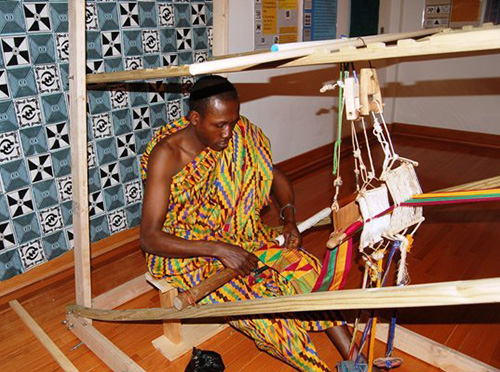
Man in kente cloth hand-weaving on a wooden loom. Photo from Kentecloth.net. By the way, kente is usually woven by males
But not only the finished pattern has a meaning but every color of it does. Here is a short list:
- red – blood; strong political and spiritual feelings;
- pink – calmness, tenderness, and similar qualities;
- yellow – yolk of the egg; some fruits and veggies; holy and precious things;
- gold – wealth, royalty, etc.;
- white – white of the egg; white clay used in some rituals; healing; purity;
- maroon – Earth; mother; healing and protection from evil;
- purple – Earth; healing;
- blue – sky; harmony, peace, good fortune, love;
- green – plants; growth and good health;
- silver – moon; purity and serenity;
- gray – ashes; spiritual cleansing;
- black – aging; strong spiritual energy, the spirits of the ancestors.



mindfulness
twink studios
Abi Smith
for more infomation please contact me on
6329
Thank you